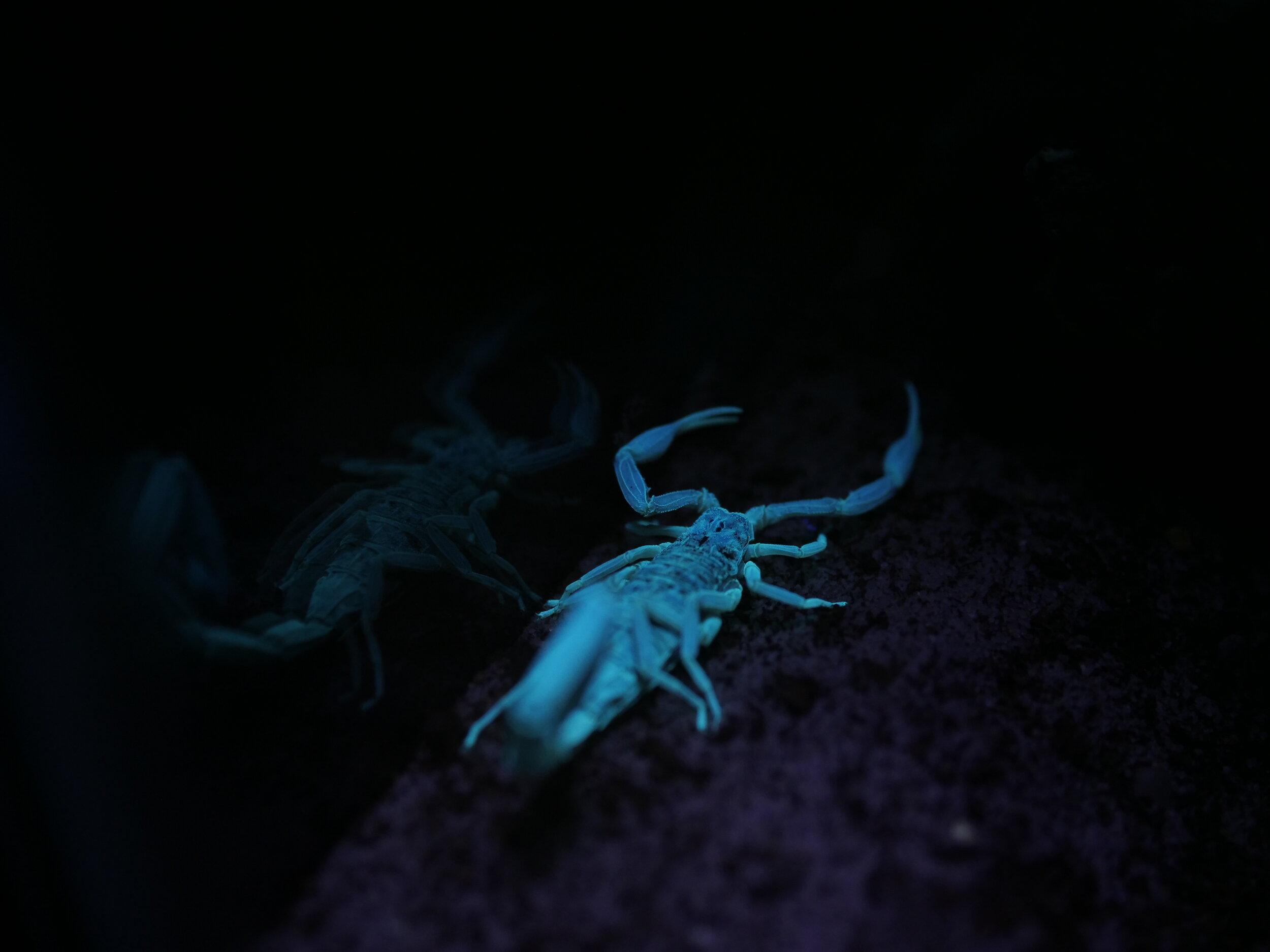Centruroides gracilis
(Florida Bark Scorpion)
Care & Husbandry
Care & Husbandry Video
I show you exactly how I set up, feed, and care for my Centruroides gracilis. I also include some interesting facts and endemic location for the Florida Bark Scorpion.
Scientific Name: Centruroides gracilis
Common Name: Florida Bark Scorpion, Slender Brown Scorpion, Brown Bark Scorpion, Caribbean Dusky Scorpion, and Blue Scorpion
Type: Semi-arboreal
Endemic Location: Florida, Cuba, Southern United States, Northern South America & Central America
Diagonal Leg Span (DLS): 3” - 4.5” (7.5-11.5cm)
Growth Rate: Fast
Life Expectancy: Females 3-4 years / Males 2 years
Recommended Experience Level: Intermediate
Venom: Neurotoxic and Cardiotoxic (effects: pain, redness, itching, and swelling) Specimens from Central and South America are reported to have a higher venom level than the North American varieties.
The Centruroides gracilis or Florida Bark Scorpion actually originated in Cuba but can now be found in a lot of the southern United States and Northern parts of South America. They have even been found in the Canary Islands, Gabon and Cameroon, most likely unintentionally brought there by people. This is a semi arboreal species that live mostly on the bark of trees or under fallen trees.This species is known to climb up the base of trees and find hiding place in the crevices of the bark. They are a communal species and can be found in nature sharing the same hides and living in very close proximity to each other. They can grow to between 3.4-4.5 inches in size with the males being longer and skinnier with elongated metasoma segments while the females are thicker or stockier. They mostly have a reddish brown color but are polymorphic, meaning there are different color variations even within one brood. Some appear to be more black or different shades of brown, black with red chelae, dark brown with yellowish legs, or dark brown with reddish and black tail sections. These scorpions are not very defensive but definitely skittish. When disturbed they will usually try to retreat and hide as opposed to standing their ground or trying to sting. They can move very fast so always be mindful of that.
This is a communal species and I have had no issues keeping mine together as adults. The Bark scorpions are prolific breeders so you should expect that you will eventually have gravid females if you are keeping males and females together. On average, their broods can be anywhere from 8 to as many as 30. The first brood in my care was 35 scorplings, though about 5 of them were sickly and didn't live very long after leaving their mother's back. When my gravid female has a brood, I carefully remove her from the communal and set her up in her own small enclosure to raise her young in peace without having to worry about the other scorpions trying to eat her young. Scorplings climb on to the moms back and stay there during the first instar of their life, feeding off the nutrients the mother excretes from her back. After they molt, they enter their 2nd instar stage and still spend a lot of time on her back at first but start wandering off and exploring. Once most of the scorplings have moved off their mother, I begin to carefully remove them, one by one and place them in their own tiny enclosures. I use small 2oz deli cups with ventilation holes in the sides and top. It is important to separate them at this stage of life because they become cannibalistic as juveniles, usually attacking and eating their siblings when they are molting. I then re-introduce the mother back to the communal. It is important to know that most likely she will mate again shortly after being reintroduced and can have another brood within 4-6 months. Males typically reach sexual maturity around the 6 or 7th instar with females being able to have young at the 7i
For the first few molts, I keep my scorpling in the small deli cups on a mixture of 60/40 peat moss (coco fiber) and sand. They don't really do any burrowing, so it is important to add a small piece of cork bark they can hide under and climb. I just cut a cork bark flat into small chunks and place them in there. These scorpions do require humidity, especially at this size, so I dribble a little water on the substrate to keep it a little damp and lightly mist their enclosures twice a week. I also will put in a little piece of sphagnum moss to help maintain the humidity levels. I also keep them in my spiderling nursery that has an ambient temperature and humidity higher than that of the rest of the room. I keep the temp in the nursery around 78f (26c)
Once they outgrow those enclosures I move them into the same type of enclosures I use a lot for my spiderlings, but 8 or 16 oz deli cups would work as well. These scorplings grow quickly, usually reaching adult sizes in 7 or eight months, and there may be a lot of them, so you don't need to invest a lot of money in fancy enclosures unless you just have one two. I use the same mixture of substrate, add a taller piece of cork back, and keep the substrate slightly damp and mist the enclosure once or twice a week. I also keep these sized enclosures in the nursery so they are a little warmer.
When they have reached near adult size, around 3”, I introduce them into the communal setup I have. It is important that there is plenty of vertical room and things for them to climb and hide. Currently I am using the exo terra small tall enclosure that measures 12x12x18 with 3 different large pieces of cork bark leaned up against the sides. I keep a large, but very shallow water dish in the middle of the enclosure and keep it full. It is very important that the dish be shallow because if you use a deep water bowl, there could be problems. Unlike tarantulas, scorpions can drown in their water dish, so keep them shallow and easy for them to get out. I also mist this enclosure down once or twice a week and keep the substrate slightly damp. I also put a small Under Tank Heater on the back side of the enclosure to give them an area that is slight warmer than the rest of the enclosure. The temp in that section does not go above 82f (28c). There are many other keepers that insist a heat pad is not necessary and keep theirs at room temperatures.
I think this species would do very well in a bioactive setup as they prefer a higher humidity and I plan on converting their current setup into a bioactive enclosure in the near future.
As far as feeding, I feed my smallest scorplings one pinhead or very small cricket once or twice a week. You can also use pinhead red runners, or other small prey no larger than the scorpion. I usually smash the heads of any prey that is more than half the size of the scorpling so it is still moving and twitching, but won't be able to bite. I remove any uneaten prey or left overs the next day. It is important to spot clean because the higher humidity can lead to issues with mold and mites if you leave uneaten organic matter in their enclosures.
Once they have gotten a little larger and are in their juvenile stage, I feed them on small cricket once or twice a week. When they start looking plump I feed them no more than once a week, but sometimes every other week. I wait 4-5 days after a molt before attempting to feed them again.
And for adults, I feed 2-3 medium or 1-2 large crickets a week at first and cut back the amount and frequency as they get more plump. If you are keeping them communally it is a little different. For my communal, I usually drop in 2-3 crickets per scorpion once a week. If I notice there are no crickets in the enclosure and it has been a few days since they have been fed, I will drop in a few more feeders. I try to keep them well fed and prey readily accessible so they don't turn to cannibalism out of hunger. So far I have had no issues with cannibalism in this communal and have been keeping them well fed.
These scorpions, like all scorpions, are reactive to UV light, meaning their exoskeletons glow under black light, except right after a molt. This comes in very handy when rehousing, spot cleaning their enclosure, or feeding. I turn on the black light or use my black light flashlight while interacting with them because it makes them very easy to see. These scorpions blend in very well with the work bark and even seem to be camouflage on the substrate and can be easy to look over. So using a black light really helps to make things easier.












